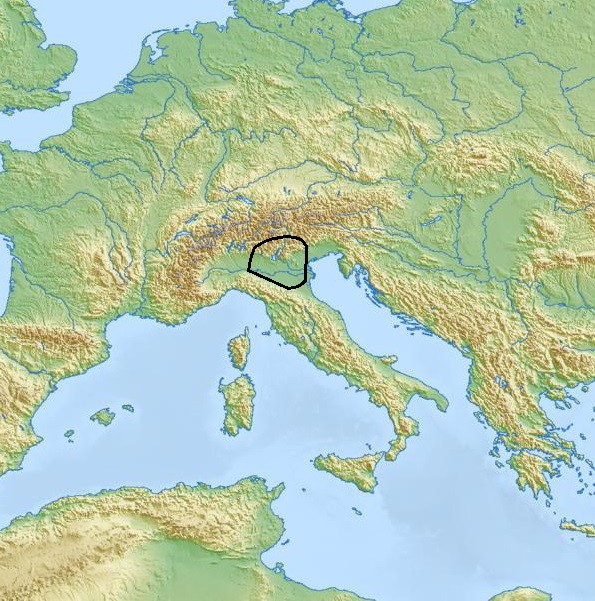Remedello Culture on:
[Wikipedia]
[Google]
[Amazon]
 The Remedello culture (Italian ''Cultura di Remedello'') developed during the Copper Age (4th and 3rd millennium BC) in Northern Italy, particularly in the area of the Po valley. The name comes from the town of Remedello (
The Remedello culture (Italian ''Cultura di Remedello'') developed during the Copper Age (4th and 3rd millennium BC) in Northern Italy, particularly in the area of the Po valley. The name comes from the town of Remedello (
 The Remedello culture (Italian ''Cultura di Remedello'') developed during the Copper Age (4th and 3rd millennium BC) in Northern Italy, particularly in the area of the Po valley. The name comes from the town of Remedello (
The Remedello culture (Italian ''Cultura di Remedello'') developed during the Copper Age (4th and 3rd millennium BC) in Northern Italy, particularly in the area of the Po valley. The name comes from the town of Remedello (Brescia
Brescia (, locally ; lmo, link=no, label= Lombard, Brèsa ; lat, Brixia; vec, Bressa) is a city and ''comune'' in the region of Lombardy, Northern Italy. It is situated at the foot of the Alps, a few kilometers from the lakes Garda and Iseo ...
) where several burials were discovered in the late 19th century.
First excavations
The first burials were discovered in the winter of 1884, the excavations were initiated by Gaetano Chierici, but, as a result of the low temperatures, he fell ill and died. The excavations continued under the direction of Giovanni Bandieri, who moved the relics to the Museum of Reggio Emilia.The burials
The Copper Age graves contained a single body in a crouching or supine position with the head facing north-west. The male set was represented by arrows, stone daggers and polished stone axes, among the tombs few are those with axes and daggers or ornaments made of copper. The female burials are accompanied by ceramic vessels or (in rare occasions) ornaments. The graves of children contained simple kits of flint stone. Among the found items noteworthy is the presence of extremely accurate works in flint stone as axes and other weapons, objects in copper and arsenical silver (arms, pins, pectorals, bracelets), all of them characterized by decorative elements of eastern origin.Genetics
In a 2015 study published inNature
Nature, in the broadest sense, is the physical world or universe. "Nature" can refer to the phenomena of the physical world, and also to life in general. The study of nature is a large, if not the only, part of science. Although humans are ...
, the remains of three individuals ascribed to the Remedello culture were analyzed. All of them were determined to belong to haplogroup I.
Chronology
Although most of the discovered tombs date to theChalcolithic
The Copper Age, also called the Chalcolithic (; from grc-gre, χαλκός ''khalkós'', "copper" and ''líthos'', "stone") or (A)eneolithic (from Latin '' aeneus'' "of copper"), is an archaeological period characterized by regular ...
, burials from the Bronze Age
The Bronze Age is a historic period, lasting approximately from 3300 BC to 1200 BC, characterized by the use of bronze, the presence of writing in some areas, and other early features of urban civilization. The Bronze Age is the second prin ...
and the Iron Age
The Iron Age is the final epoch of the three-age division of the prehistory and protohistory of humanity. It was preceded by the Stone Age ( Paleolithic, Mesolithic, Neolithic) and the Bronze Age ( Chalcolithic). The concept has been mostl ...
have also been recovered.
The Remedello culture has been recently periodized by scholars into two distinct historical periods both dating back to the Copper Age.
Remedello I : 3400 / 3200 BC - 2800 BC, or ancient Copper Age stage;
Remedello II: 2900 / 2800 BC - 2400 BC, or full Copper Age stage.
Notes
See also
* Bagnolo stele *Beaker culture
The Bell Beaker culture, also known as the Bell Beaker complex or Bell Beaker phenomenon, is an archaeological culture named after the inverted-bell beaker drinking vessel used at the very beginning of the European Bronze Age. Arising from a ...
*Chalcolithic
The Copper Age, also called the Chalcolithic (; from grc-gre, χαλκός ''khalkós'', "copper" and ''líthos'', "stone") or (A)eneolithic (from Latin '' aeneus'' "of copper"), is an archaeological period characterized by regular ...
*Prehistoric Italy
The prehistory of Italy began in the Paleolithic period, when species of '' Homo'' colonized the Italian territory for the first time, and ended in the Iron Age, when the first written records appeared in Italy.
Paleolithic
In prehistoric t ...
External links
* * *{{Cite web, url=http://www.iipp.it/?p=575, title=Atti della XXXI riunione scientifica IIPP "La Valle d'Aosta nel quadro della preistoria e protostoria dell'arco alpino centro-occidentale" su "Istituto Italiano di Preistoria e Protostoria", access-date=2009-10-06 Chalcolithic cultures of Europe Archaeological cultures of Southern Europe Archaeological cultures in Italy